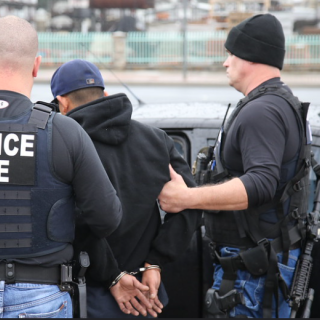Advertisement
I grew up in a church-going family. In fact, for my entire life we either lived next door or one street over from Hilltop United Methodist Church. In 1976, I converted to Catholicism. I grew up down the street from St. Aloysius Catholic Church, and it is across the street from the elementary school my siblings and I attended. I always wondered what was going on in there, and after graduating from high school in 1974 started going to services, making sure to sit in the back of the church. I thought the service–the mass–was lovely.
There was a Black priest who during the service admonished the congregation to put a little more oomph in their responses; in fact, he suggested that we answer as heartily as people cheer at OSU football games. Several weeks later, I went by the church to see if I could talk to that priest about converting, and while he wasn’t there, the priest who answered the door offered to give me instruction.
Forty-seven years later, I still identify as Catholic, although I’d be the first to admit I am not as fervent about attending mass as I was back then or should be now. I’m also still in touch with Father Jerry Stluka, who gave me my instruction, and twenty-six years after I attended that first mass presided over the funeral of my twice divorced, Quaker fiancé. I love the ritual and pageantry of the mass, the Rosary, and many of the devotions, such as compline, the chaplet of Divine Mercy, and the Stations of the Cross.
It was no surprise to me that the Catholic church in American bought, owned, and sold black slaves. So I was anxious to read The 272. Who are the Jesuits? How would the church justify the buying, selling, and owning of human beings?
The Society of Jesus, more commonly known as the Jesuit Order or SJ, “is a religious order of clerics regular of the pontifical right for men in the Catholic Church and is headquartered in Rome.” The Jesuit order was founded by a nobleman named Ignatius, who had a background of military service; therefore, Jesuits are sometimes referred to as soldiers of God. It is a consecrated order whose patron is the Blessed Virgin Mary.
Jesuits take a vow of “perpetual poverty, chastity, and obedience,” and pledge special obedience to the Pope. This means they must accept that they can be sent anywhere in the world, regardless of favor or hardship. The Jesuits were specifically charged with reinforcing Catholic doctrine during the period of the counter-Reformation, and were often seen as too forceful when doing so. They are known for their teaching and scholarship.
Swarns centers her story on the life of the indentured servant–the status is different than that of slavery as it requires only a fixed number of years– Ann Joice, who was brought to Maryland in 1676. Joice had a written contract that verified she would become free after her indenture was complete, but it was destroyed by her owner, and thus she entered into lifelong slavery. Her condition as a slave was also passed down to subsequent generations. One of her descendants, Harry Mahoney met and married a woman named Anna, and they had eight children, including little Anny. She married a man named Arnold Jones, and together with millions of other slaves across the South lived with the terror of being sold away from families. Leaving his wife and children behind, Arnold escaped and made his way North. Anny, Louisa, and Arnold Jr., along with many others, were sold by the Jesuits in 1838.
The Jesuits were firmly committed to lives as southern planters and slave holders, and for the most part, do not have appeared to have any qualms about the buying and selling of Blacks. Indeed, they held the common view of Blacks during that time: they were inferior and uncivilized, so enslaving them was for their own good. While some individual priests were troubled by this, their niggling doubt was pushed aside by the interest of making enough money to establish a Catholic men’s school, what is now Georgetown University. The sale of the original 272 enslaved ensured the success of their endeavors. They were also deeply involved in the management of the plantations, and gave strict instructions to the owners to operate them in a manner that maximized efficiency and profits.
The income from the original Maryland plantation and several others allowed the Jesuits to finance a number of schools and institutions of higher learning. When thousands of Irish began immigrating to urban areas in the north in the 1840s, the institutional church was able to provide them with educational and economic assistance, reinforce their spiritual health, rapidly increase the spread of the Catholic faith, and further increase their influence on American society.
The Jesuit community spread west of the Mississippi and with slave labor built and administered colleges in Ohio, Louisiana, Kentucky, and Alabama. There was even some discussion by the leadership of “reaping a harvest of souls” among the millions of newly freed Blacks after the Civil War. Yet as with much of white America, the bishops clung to their prejudices and decided to make no special provision for them.
Indeed, Black Catholics found their churches just as racist as other institutions in American society. Segregation in the church was the norm, especially among children. The rituals of communion, catechism, and confirmation were rigidly policed so as to ensure the impossibility of interracial services. Yet when freedom came, many descendants of the original 272 enslaved people continued to practice their Catholic faith, passing it on to subsequent generations.
A reconciliation ceremony was held in April 2017 during which the Jesuits apologized for the sale and enslavement of Black people. The formal penitential right of the Church, the Act of Contrition, was used. Father Timothy Kesicki intoned the ancient prayer: “It was our fault, our fault, our most grievous fault.”
The 272 also takes on the thorny question of reparations. Georgetown University has sought to make amends in several ways. First, descendants of the enslaved who applied to Georgetown would be awarded preferential admission status. Second, they established the Carroll Fund for the purpose of awarding scholarships to Black students who decide to attend Jesuit schools. Some were suspicious of the Fund, which has provided more than fifteen million dollars to Black students, because its origins had been kept a secret. It was apparently so controversial the Jesuits liquidated it and sent the proceeds to various Jesuit schools after Swarns’ first story about the order’s ties to slavery was published. Third, the Jesuits vowed to raise $100 million, half of which would be used for racial reconciliation projects. So far, fund-raising for the programs has been much less than was hoped for.
Swarns is a professor of journalism at New York University, and a Black Catholic. She wrote the well received book American Tapestry: The Story of the Black, White, and Multiracial Ancestors of Michelle Obama, which traced Ms. Obama’s family from the Revolutionary War–a story she herself did not know–through the twenty first century. Swarns has also won a number of prestigious awards from foundations and organizations, including the National Endowment for the Humanities and the Ford Foundation for her work.
The 272 is gracefully written and propitiously timed. It has inspired Princeton Theological Seminary, the Virginia Theological Seminary, and the Society of the Sacred Heart, a Catholic sisters organization, to create their own reparations programs in an effort to expiate the sin of slaveholding. Furthermore, other colleges and universities in the United States are investigating their ties to slavery, including Brown University, Barnard College, Columbia University, Dartmouth College, and Harvard University and are working in various ways to make amends.
Somebody say Amen!



